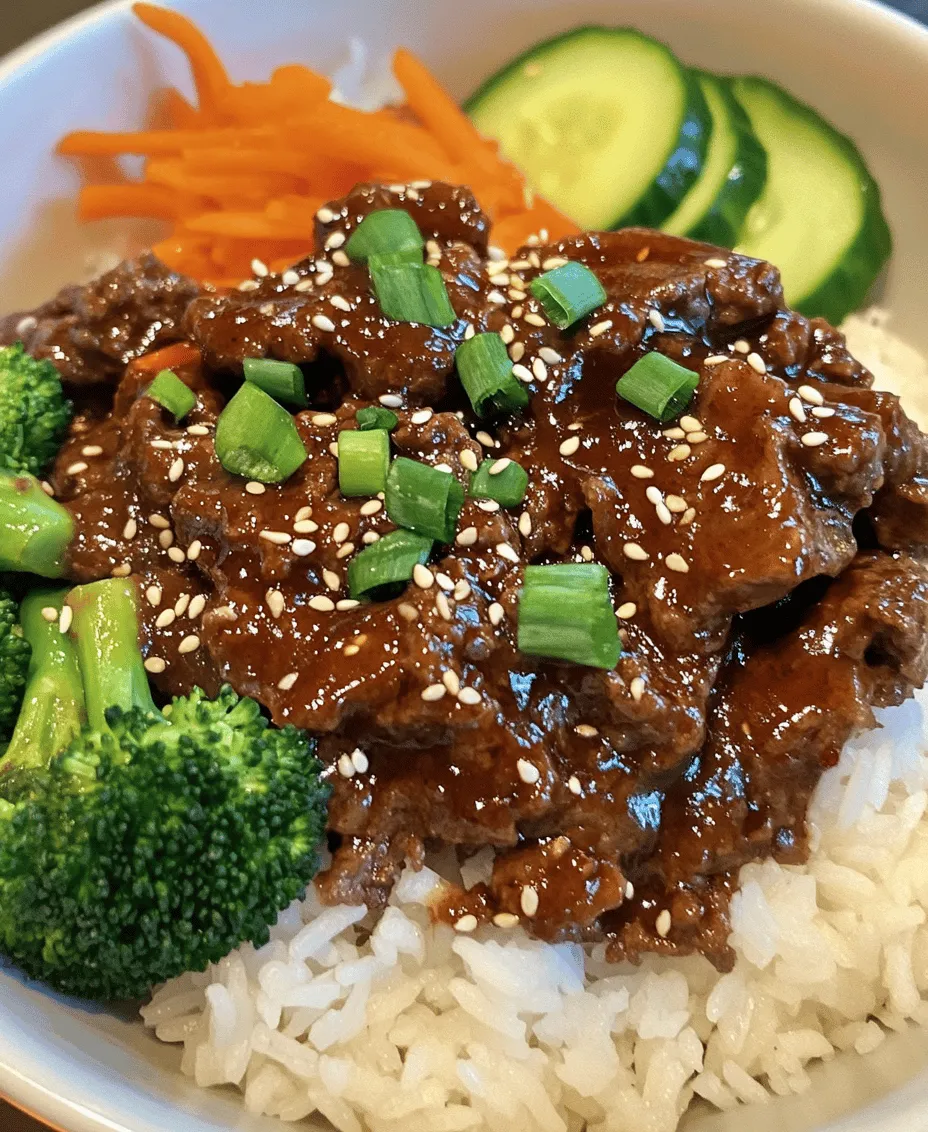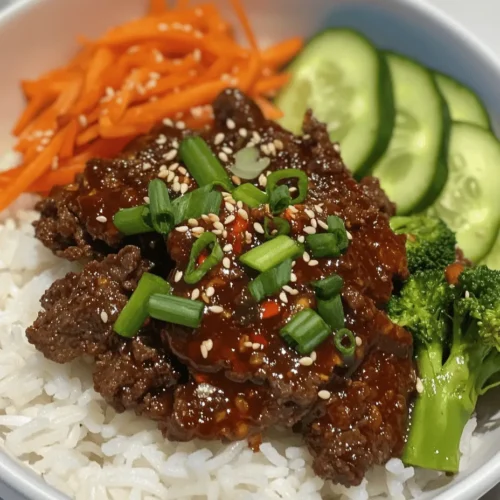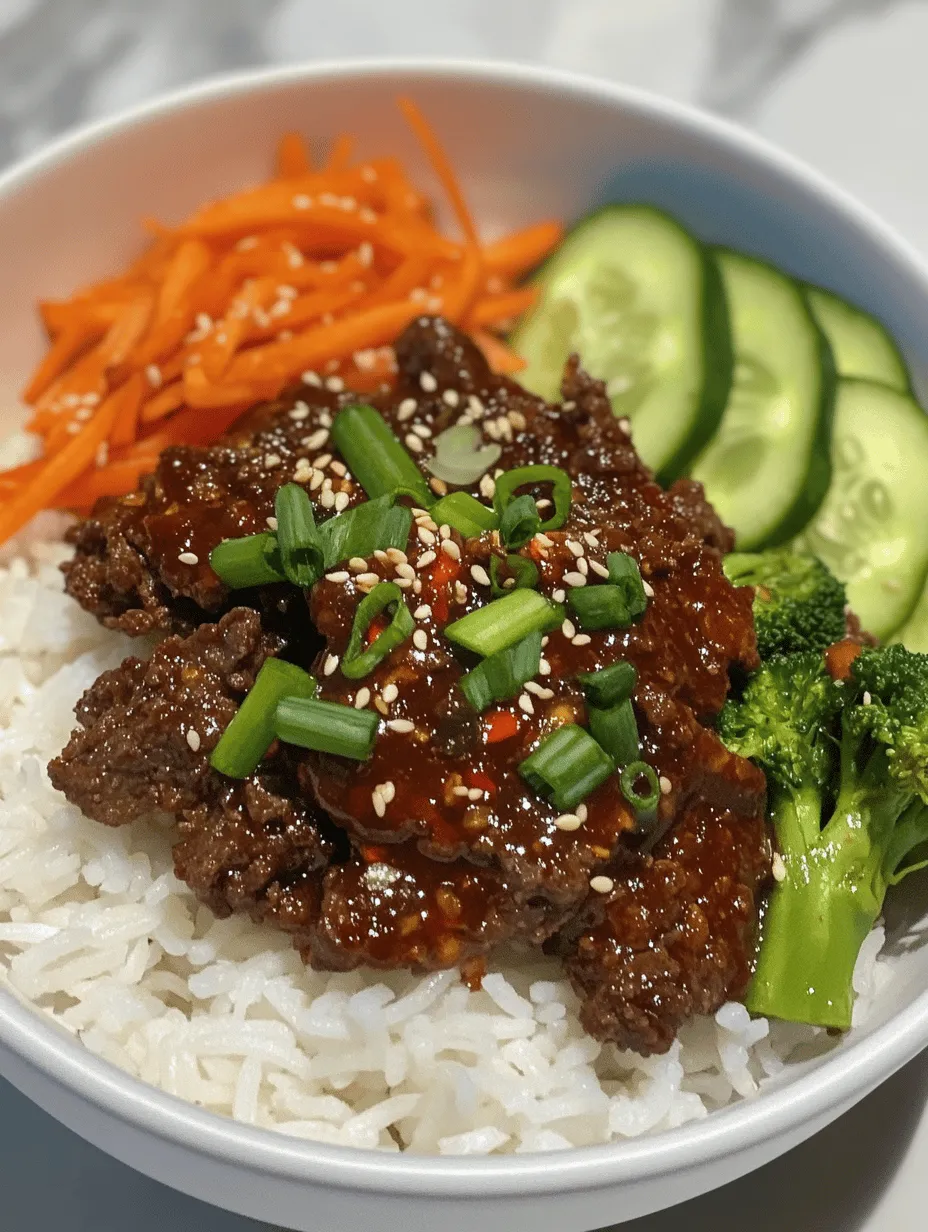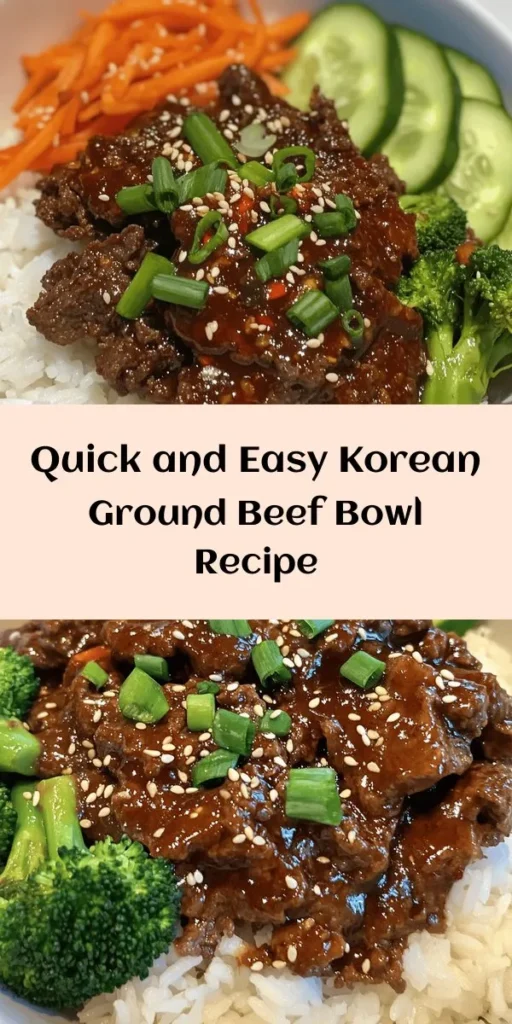Korean cuisine has taken the culinary world by storm, renowned for its vibrant flavors, unique textures, and the ability to blend contrasting elements into harmonious dishes. Among the many delightful offerings of this cuisine, Korean Ground Beef Bowls stand out as a practical and nutritious meal option that appeals to a wide audience. These bowls offer a perfect balance of protein, vegetables, and carbohydrates, catering to various dietary preferences while satisfying the palate with their robust flavors.
The Appeal of Korean Ground Beef Bowls
Korean Ground Beef Bowls are not just a meal; they are an experience. With the rich umami flavor of soy sauce, the spicy kick from gochujang, and the nutty aroma of sesame oil, each bite transports you to the bustling streets of Seoul. The beauty of this dish lies in its adaptability; it can be whipped up in under 30 minutes, making it a fantastic choice for busy weeknights or meal prep. Furthermore, the combination of ground beef, fresh vegetables, and rice ensures a well-rounded meal that is both filling and nutritious.
Whether you are a seasoned cook or a culinary novice, this dish is accessible and easy to prepare. It allows you to experiment with flavor profiles while providing a comforting and satisfying meal that can be customized to meet your taste preferences. In the following sections, we will delve into the key ingredients that make up this delicious bowl and walk you through the step-by-step process of creating your own Korean Ground Beef Bowl.
Understanding the Key Ingredients
To create an authentic and flavorful Korean Ground Beef Bowl, it is essential to understand the key ingredients that contribute to its delightful taste and nutritional value.
Ground Beef: The Primary Protein Source
Ground beef serves as the heart of this dish, providing a substantial source of protein that is both flavorful and satisfying. When selecting ground beef, you can choose from various types, such as lean, extra-lean, or even grass-fed options, based on your dietary preferences. The fat content in the beef not only contributes to the overall taste but also helps to keep the meat moist during cooking.
Soy Sauce: The Umami Flavor Booster
Soy sauce is a staple in Korean cooking, recognized for its deep, savory flavor that enhances any dish. It provides an essential umami component, making the beef taste richer and more satisfying. For the best results, opt for low-sodium soy sauce to control the saltiness of your dish while still achieving that desired savory quality.
Gochujang: The Spicy Korean Staple
Gochujang, a fermented chili paste, is a cornerstone of Korean cuisine. This ingredient adds a unique depth of flavor and a spicy kick to the ground beef. It is made from red chili powder, glutinous rice, fermented soybeans, and salt, resulting in a complex flavor profile that is both sweet and spicy. Depending on your heat tolerance, you can adjust the amount of gochujang in your recipe to achieve the desired spice level.
Sesame Oil: The Aromatic Touch
Sesame oil is another signature ingredient in Korean recipes, known for its warm, nutty flavor and fragrance. A small amount of sesame oil goes a long way in elevating the overall taste of the dish. It adds richness and depth, making the ground beef bowl not only delicious but also aromatic.
Fresh Garlic and Ginger: Depth of Flavor
No Korean dish is complete without the aromatic duo of fresh garlic and ginger. Both ingredients bring complexity and warmth, enhancing the flavor of the ground beef. Garlic adds a pungent kick, while ginger offers a subtle heat and freshness that balances the richness of the meat.
Brown Sugar and Rice Vinegar: Balancing the Flavors
Incorporating brown sugar and rice vinegar into your marinade is essential for balancing the bold flavors in the dish. Brown sugar adds a touch of sweetness, which contrasts beautifully with the saltiness of the soy sauce and the heat from the gochujang. Rice vinegar, on the other hand, provides a mild acidity that rounds out the flavors, ensuring that the dish is well-balanced and satisfying.
Jasmine Rice: The Perfect Base
Every great bowl needs a solid base, and jasmine rice is the perfect choice for this Korean Ground Beef Bowl. With its fragrant aroma and slightly sticky texture, jasmine rice complements the beef and vegetables beautifully. It acts as a canvas for the dish, soaking up all the delicious flavors from the marinade and sauces.
Colorful Vegetables: Nutritional Benefits
To make your Korean Ground Beef Bowl a complete meal, adding colorful vegetables is a must. Broccoli and carrots are excellent choices; they not only add vibrant colors to the dish but also provide essential nutrients. Broccoli is rich in vitamins C and K, while carrots are an excellent source of beta-carotene, fiber, and antioxidants. Together, they enhance the nutritional profile of your meal while adding texture and crunch.
Step-by-Step Guide to Preparing Korean Ground Beef Bowls
Now that we have explored the key ingredients that comprise the Korean Ground Beef Bowl, let’s dive into the step-by-step guide to preparing this delicious dish.
Preparing the Vegetables
The first step in creating your Korean Ground Beef Bowl is preparing the vegetables. For this recipe, we will focus on steaming broccoli and sautéing carrots to achieve optimal texture and flavor.
1. Steaming Broccoli:
– Begin by washing the broccoli and cutting it into bite-sized florets.
– Bring a pot of water to a boil and place a steamer basket over the pot, ensuring the water does not touch the bottom of the basket.
– Add the broccoli florets to the steamer basket, cover, and steam for about 4-5 minutes, or until the broccoli is vibrant green and tender-crisp.
– Once done, remove the broccoli from the heat and set it aside.
2. Sautéing Carrots:
– While the broccoli is steaming, peel and slice the carrots into thin rounds or matchsticks for quicker cooking.
– Heat a tablespoon of oil in a skillet over medium heat.
– Add the sliced carrots and sauté for about 3-4 minutes, or until they are tender yet still slightly crisp.
– Season with a pinch of salt to enhance their natural sweetness. Once cooked, remove them from the skillet and set aside.
Making the Marinade
Next, we’ll create a savory marinade that imbues the ground beef with flavor.
1. Combining Ingredients:
– In a medium bowl, combine the soy sauce, gochujang, sesame oil, minced garlic, minced ginger, brown sugar, and rice vinegar.
– Whisk the ingredients together until well combined. Taste and adjust the seasoning as needed. If you prefer a spicier dish, feel free to add more gochujang.
Cooking the Ground Beef
Now it’s time to cook the ground beef, ensuring it is browned perfectly for the best flavor and texture.
1. Browning the Ground Beef:
– In the same skillet you used for the carrots, add a bit more oil if necessary and heat it over medium-high heat.
– Add the ground beef to the skillet, breaking it apart with a spatula or wooden spoon.
– Allow the beef to cook undisturbed for a couple of minutes to develop a nice browning.
– Stir occasionally, cooking until the beef is fully browned and no longer pink, approximately 5-7 minutes.
2. Incorporating the Marinade:
– Once the beef is cooked, drain any excess fat if necessary, then pour the prepared marinade over the beef.
– Stir to combine, allowing the beef to absorb the flavors from the marinade. Cook for an additional 2-3 minutes until everything is heated through and well mixed.
In the next part of this article, we will cover the assembly of the bowl and provide tips for serving and customizing your Korean Ground Beef Bowl to suit your tastes. Stay tuned for more delicious insights into this vibrant dish!

Combining with Sauce
Once your ground beef is browned and cooked to perfection, it’s time to meld the flavors together by adding the sauce. This step is crucial as it allows the meat to absorb the rich, savory taste of the sauce, enhancing the overall flavor profile of your Korean Ground Beef Bowl.
1. Add the Sauce: Pour the prepared sauce over the cooked beef in the skillet. The sauce typically consists of soy sauce, brown sugar, garlic, and a hint of sesame oil. The combination of these ingredients creates a perfect balance of sweet, salty, and umami flavors.
2. Simmer: Reduce the heat to medium-low and allow the beef to simmer in the sauce for about 3-5 minutes. This simmering process helps the beef soak up the flavors while thickening the sauce slightly. Stir occasionally to ensure that the beef is evenly coated.
3. Taste and Adjust: Before serving, taste the beef and adjust the seasoning if necessary. Depending on your preference, you might want to add a bit more soy sauce for saltiness or a pinch more brown sugar for sweetness.
This step not only infuses the meat with flavor but also creates a delicious sauce that will soak into the rice and vegetables when assembled in the bowl.
Assembling the Bowls
With your flavorful beef ready, it’s time to assemble the bowls. The presentation is just as important as the taste, and a well-assembled bowl not only looks appealing but also balances the flavors and textures.
1. Start with Rice: Begin by serving a generous portion of steamed rice at the bottom of each bowl. You can use white rice, brown rice, or even cauliflower rice for a low-carb option. The rice acts as a neutral base that absorbs the delicious sauce from the beef.
2. Layer the Beef: Next, spoon the saucy ground beef over the rice. Allow some of the sauce to drizzle down into the rice to enhance the flavor of the base.
3. Add Vegetables: Incorporate a colorful array of vegetables. Traditional options include shredded carrots, cucumber slices, and steamed broccoli. These not only add crunch but also bring a fresh taste that balances the richness of the beef.
4. Top with Egg: For an authentic touch, consider adding a fried egg on top. The runny yolk, when broken, adds a creaminess that elevates the dish further.
This layered approach not only makes the bowl visually appealing but also ensures that every bite contains a harmonious mix of flavors.
Garnishing & Serving
To elevate your Korean Ground Beef Bowl even further, garnishing is key. Here are some suggested toppings that will add both flavor and visual appeal:
1. Sesame Seeds: Toasted sesame seeds provide a nutty flavor and a satisfying crunch. Sprinkle them generously over the top of your assembled bowl.
2. Green Onions: Finely chopped green onions add a fresh, mild onion flavor. They also bring a nice pop of color to the dish.
3. Kimchi: For a spicy and tangy kick, serve a side of kimchi. This traditional fermented vegetable dish complements the flavors of your beef bowl beautifully.
4. Nori Strips: Consider adding strips of nori (dried seaweed) for an additional umami flavor and a hint of ocean freshness.
When serving, consider offering some of these garnishes on the side so that everyone can customize their bowls to their liking.
Nutritional Analysis of Korean Ground Beef Bowls
Understanding the nutritional content of your Korean Ground Beef Bowl is essential for those looking to maintain a balanced diet. Here’s a breakdown of the average calories, protein, fats, and carbohydrates per serving:
– Calories: Approximately 500-600 calories per serving, depending on the portion sizes and ingredients used.
– Protein: Around 30-35 grams, primarily from the ground beef, making it a fantastic option for muscle repair and growth.
– Fats: About 20-25 grams, with healthy fats coming from sesame oil and any additional toppings like eggs or avocado.
– Carbohydrates: Roughly 60-70 grams, mainly from the rice and vegetables, providing a good source of energy.
Health Benefits:
– High Protein: The ground beef provides a substantial amount of protein necessary for muscle repair and overall health.
– Fiber from Vegetables: Including a variety of vegetables increases the fiber content, which is beneficial for digestive health.
– Healthy Fats: Sesame oil and any added avocado contribute healthy fats that support heart health.
Variations and Adaptations
One of the best aspects of the Korean Ground Beef Bowl is its versatility. Here are some variations and adaptations that can cater to different dietary needs or personal preferences:
1. Alternative Proteins: If you’re looking to switch things up, consider using ground turkey, chicken, or even a plant-based protein like lentils or crumbled tofu. These options can provide a different flavor profile while maintaining the essence of the dish.
2. Vegetable Variations: Feel free to incorporate other vegetables based on what you have on hand or your personal preferences. Bell peppers, snap peas, or baby spinach can add color and additional nutrients.
3. Gluten-Free Adaptations: For those who need to avoid gluten, simply substitute regular soy sauce with tamari, which is a gluten-free alternative. This small change allows you to enjoy the same great flavors without compromising dietary restrictions.
4. Spice Adjustments: Adjust the heat level according to your taste. If you prefer a spicy kick, add some gochujang (Korean chili paste) to the sauce or sprinkle some red pepper flakes over the finished bowl.
Cultural Significance of Korean Cuisine
Korean cuisine is rich in tradition and flavors, with a strong emphasis on communal eating. Dishes like the Korean Ground Beef Bowl are often enjoyed in a family setting, highlighting the importance of sharing meals together.
The use of vibrant ingredients and bold flavors reflects a deep cultural appreciation for food as a means of nourishment and social connection. Bowls like this not only provide sustenance but also create a sense of togetherness, encouraging diners to engage in conversation and bond over their meal.
Additionally, Korean cuisine is known for its balance of flavors and textures. The integration of sweet, salty, sour, and spicy elements creates a complex culinary experience that is both satisfying and memorable.
Conclusion: Embracing Korean Ground Beef Bowls in Your Kitchen
Korean Ground Beef Bowls are an exciting addition to any home cook’s repertoire, offering a flavorful and satisfying meal that can be easily adapted to suit various tastes and dietary needs. The simplicity of preparing this dish, combined with the depth of flavor from the sauce and the vibrant presentation, makes it a perfect weeknight dinner option.
As you explore the world of Korean cuisine, don’t hesitate to experiment with different ingredients and techniques. Discovering new flavors and learning about the cultural significance of these dishes can enhance your cooking experience and bring a taste of Korea to your dinner table.
Whether you’re enjoying this meal solo or sharing it with loved ones, Korean Ground Beef Bowls are sure to delight and satisfy. Embrace the joy of cooking and the flavors of Korea in your kitchen today!



